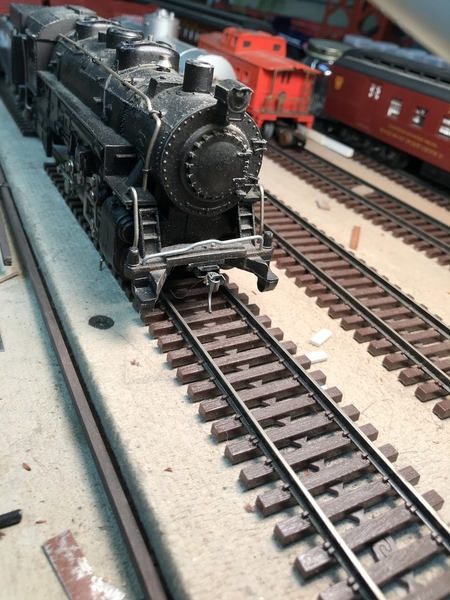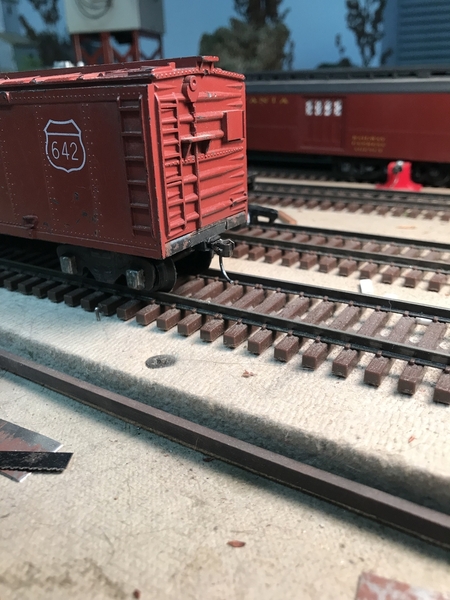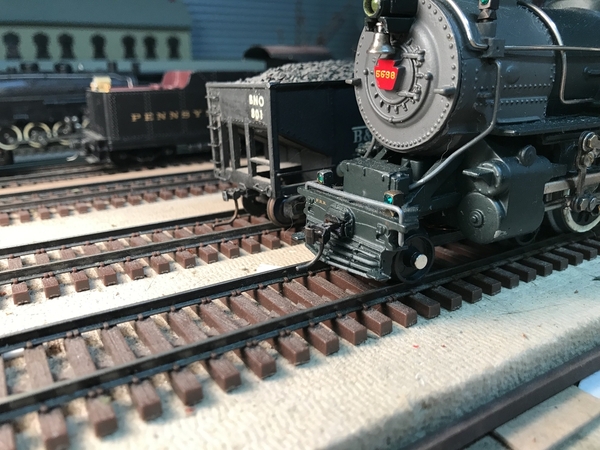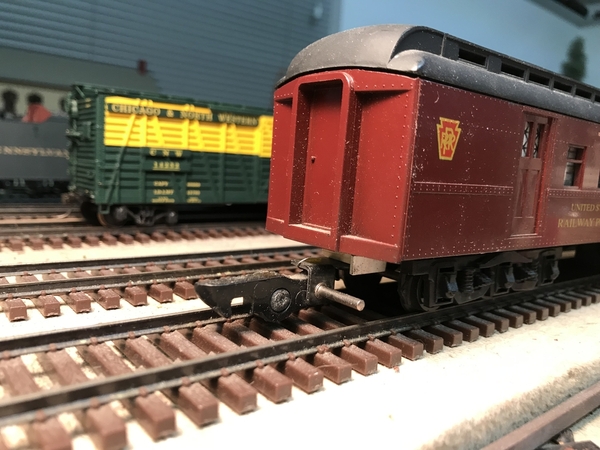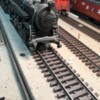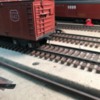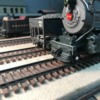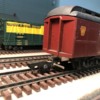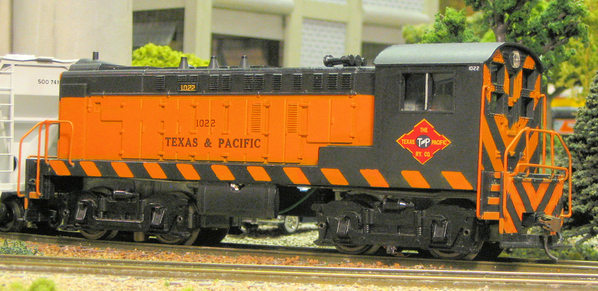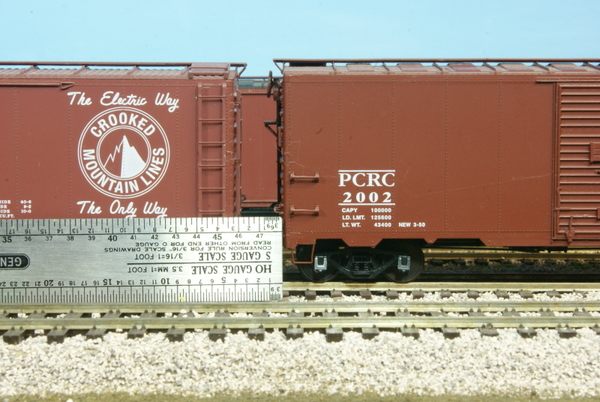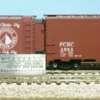The MTH / SHS track is listed as code 125 but then I see folks saying it's actually 138. What is it?
@Jacobpaul81 posted:The MTH / SHS track is listed as code 125 but then I see folks saying it's actually 138. What is it?
Code 138 representing prototype 125 pound per yard rail. Hence, the confusion.
***EDIT*** Ooops, Tom is correct below. 155 pound rail.
Rusty
It is NOT code 125. The rail height is .138". Supposedly it is an accurate model of a long out of use PRR 155# rail. I used the MTH flex track to build my layout.
Thanks Fellas! Good prices on MTH Flex track out there - so I wanted to make sure before I bought some that it'd work with the FV Switches.
@Jacobpaul81 posted:The MTH / SHS track is listed as code 125 but then I see folks saying it's actually 138. What is it?
Try this .pdf:
Attachments
Tom, I am not clear how to convert the dimensions on that drawing. It says the scale of the rail cross section is 10:1. If I divide the dimensions, I assume these are inches, that makes the rail height .345", clearly not correct. What am I missing?
"All Santa Fe high-speed transcontinental lines have been designated as 131-132-pound rail territory. That means that much of that mileage and all new rail laid in that territory is 131-132-pound rail except in . yards and other localities where lighter rail is preferable. The new standard 115-pound section will shortly replace the present 112-pound. Other rail weights in use by the Santa Fe are 60, 75, · 90, 110 and 112-pound. The three last-mentioned sections were standard on Santa Fe main lines for many years and considerable presentday Santa Fe rail mileage consists of those weights of rail. All Santa Fe rails are steel and have been for many years. Beginning with 1936 all rails have been control cooled by the manufacturers to eliminate as far as possible interior defects in the head of the rail." - Santa Fe Today, #5. pg. 22
https://www.railsandtrails.com...Today%20No.%205r.pdf
So 155# isn't too far off for ATSF mainline as they upgraded their 75#, 90# and 112# mains to 132# or 115#. I'm guessing Argentine to Topeka (IE: Lawrence) was probably upgraded to 132# as it was on the Chief route - so that's not a huge disparity.
@AmFlyer posted:Tom, I am not clear how to convert the dimensions on that drawing. It says the scale of the rail cross section is 10:1. If I divide the dimensions, I assume these are inches, that makes the rail height .345", clearly not correct. What am I missing?
The dimensions are metric. That's why I posted the drawing I made in another thread. Here is is again...
Tom Stoltz
in Maine
Attachments
The MTH and Fox Valley rail scales to a prototype section height of 8.83". Modern 115# rail is 6-5/8" high, 132# rail is 7-1/8" high. Then 115# rail scales to Code 100 in S scale. Problem is no high rail equipment will run on Code 100 rail, nor Code 125. For high rail wheels the MTH and Fox Valley are the smallest rails that work. I have some Code 125 rail on my layout for the TT pit rails and all the guard/guide rails on the bridges. It is so close to the .138 rail it looks the same on the layout. The most noticeable thing about the Code 125 rail is the railhead width is wider than the .138 MTH rail.
I have no issue with the appearance of the MTH rail on my layout, I know it is too tall for modern track but set in the scenery with the ballast detailing it looks close enough to scale.
Thanks Tom, I need to save that drawing.
@Trinity River Bottoms Boomer posted:Strummer, I found your tender convert to KD couplers very interesting. This is what the hobby is all about. Would love to see the vintage equipment you picked up and converted as well!
Joe
Thought I'd share a few, too:
Attachments
This was the first item I ever bought as a kid that cost more than a candy bar. It never ran well--it was only $18 at the time anyway--but I could not bear to part with it. So I dressed it up with a new motor conversion kit from Doug Peck at Portlines Hobbies and some decoration. It's slow and noisy but reliable and earns its keep.
Attachments
@TOKELLY posted:This was the first item I ever bought as a kid that cost more than a candy bar. It never ran well--it was only $18 at the time anyway--but I could not bear to part with it. So I dressed it up with a new motor conversion kit from Doug Peck at Portlines Hobbies and some decoration. It's slow and noisy but reliable and earns its keep.
Looks good to me. ![]()
Rusty
@Tom Stoltz posted:
Those are all very nice; how did you manage to get a Kadee into the K5 pilot!?! ![]()
Mark in Oregon
@Strummer posted:Those are all very nice; how did you manage to get a Kadee into the K5 pilot!?!
Mark in Oregon
Hi Mark, first let me ask you, where in Maine is your brother? Turns out there are several Mainers on this list, Gunny comes to mind.
Then to the K5. IIRC I bought a repo pilot from Doug Peck so I wouldn’t destroy the original. I started out drilling the K5 coupler pocket out along with the cast fake coupler. Then enlarged the opening by filing until I could insert a Kadee #5 draft gear box from the outside. The lip on the box acts as a stop on the outside of the pilot. Again, IIRC, I made a pad with JB Weld to seat the draft gear box on the inside. I can’t tell now because our very own Jerry Poniatowski did a custom PRR repaint for me and he painted the underside of the pilot. In hindsight, I don’t know why I just didn’t use a slab of styrene, I’m sure that would have worked just as well. In the pix from the outside you can see the hole I drilled and tapped for a 4-40 screw to mount the coupler.
The underside pix shows the coupler mounted. I did some filing of the box so the pilot truck wheels would clear while negotiating Flyer radii. I believe I used a medium overset shank, # 42, in the #5 family but it cold be the #49 long, overset shank. I did this in 2001, so please forgive my lack of recollection.
I did a similar conversion to the Flyonel Mikado. It was a little more work, but not bad.
Tom Stoltz
in Maine
Attachments
Tom
1. My brother lives in Alna. 30 degrees and currently snowing. He has zero interest in model trains. ![]()
2. So you used an HO scale #5 on that pilot: I suppose an S scale Kadee would have been a bit too large.
3. That is a beautiful paint job; noticed it straight away. ![]()
Mark in (currently 43 degrees) Oregon
@Strummer posted:Tom
1. My brother lives in Alna. 30 degrees and currently snowing. He has zero interest in model trains.
2. So you used an HO scale #5 on that pilot: I suppose an Scale Kadee would have been a bit too large.
3. That is a beautiful paint job; noticed it straight away.
Mark in (currently 43 degrees) Oregon
Alna??? He’s our next-door neighbor! Not to hi-jack this thread, my email address is in my profile.
Yes, I only use #5s and family. I have many complaints against the, what is it, the 802? The lack of close coupling is one, probably the cost is my biggest. Also by comparison, it is complex to assemble. The #5 family has various shank lengths and coupler placement, on the shank, options. When it comes to Flyer conversions, I have used many of the variations. As far as I know, there is only one shank with the 802s.
And speaking of cheap, check out my explorations for delayed magnetic uncoupling
https://ogrforum.ogaugerr.com/...magnets-and-kadee-5s
Tom Stoltz
in Dresden/Wiscasset, Maine
@Tom Stoltz posted:Alna??? He’s our next-door neighbor! Not to hi-jack this thread, my email address is in my profile.
Tom Stoltz
in Dresden/Wiscasset, Maine
Tom
Email sent...
Mark in Oregon
@Tom Stoltz posted:Yes, I only use #5s and family. I have many complaints against the, what is it, the 802? The lack of close coupling is one, probably the cost is my biggest. Also by comparison, it is complex to assemble. The #5 family has various shank lengths and coupler placement, on the shank, options. When it comes to Flyer conversions, I have used many of the variations. As far as I know, there is only one shank with the 802s.
Tom Stoltz
in Dresden/Wiscasset, Maine
Your use of the #5 family certainly makes a lot of sense. Plus, there's not that much difference between the S coupler and the HO size.
Kadee was smart to offer early on such a wide range of couplers (for almost any application) in HO. I think that, as much as anything, had a lot to do with HO becoming "the" main scale. As 'bob2" would say..."opinion". ![]()
Mark in (wet) Oregon
I've only used the Kadee HO couplers where I needed them a special application, like an offset shank on my SouthWind 2-8-0's:

and on any "vintage" cars I bought that already had them installed. Otherwise, the HO couplers look too small to my eyes.
The distance between freight cars using 802's is about 3 scale feet, which is about what it is on the prototype, so I really don't see an issue there, but to each his own.
I can see where cost can be an issue, but as I usually buy a package of 802's when I buy a locomotive or car, that difference is blunted somewhat. Plus every "scale" locomotive I've bought directly from AM, they've thrown in a package of 802's. They even installed them on my last purchase: UP E8's...
The irony is I'll have to de-install them for body mounting and fill the pilot gaps with a modified insert, a project currently on a very crowded back burner.
Rusty




